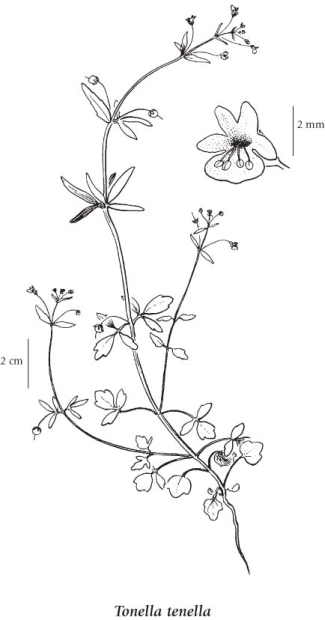Tonella tenella (Benth.) A. Heller
small-flowered tonella (lesser baby innocence)
Plantaginaceae (Mare's-tail family)
(Previously in Scrophulariaceae)
Introduction to Vascular Plants
small-flowered tonella (lesser baby innocence)
Plantaginaceae (Mare's-tail family)
(Previously in Scrophulariaceae)
Introduction to Vascular Plants
Species Information
General:
Annual herb from a taproot; stems ascending to erect, 5-25 cm tall, slender, often branched, smooth.
Leaves:
Opposite, smooth or soft-hairy on the upper surface; lowermost leaves stalked, egg-shaped to round, 1-2 cm long, few-toothed; middle and upper leaves becoming unstalked upward, deeply 3-lobed, the segments progressively narrower upward; uppermost leaves reduced and often entire.
Flowers:
Inflorescence of 1 to several long-stalked flowers in the axils of bracts, the stalks smooth or minutely glandular-hairy; corollas blue and white, short-tubular, 2-4 mm wide, 2-lipped, the upper lip 2-lobed, the lower lip 3-lobed, the middle lobe largest; calyces to 3 mm long, deeply 5-lobed, the lobes longer than the tube; stamens 4, exserted.
Fruits:
Capsules, egg- to globe-shaped; seeds 2 to 4, large, 1-1.5 mm long, wingless.
Illustration

If more than one illustration is available for a species (e.g., separate illustrations were provided for two subspecies) then links to the separate images will be provided below. Note that individual subspecies or varietal illustrations are not always available.
Illustration Source: The Illustrated Flora of British Columbia
Habitat and Range
Dry, rocky slopes in the lowland zone; rare in SW BC, known only from Saltspring Island; S to CA.Status Information
| Origin Status | Provincial Status | BC List (Red Blue List) | COSEWIC |
|---|---|---|---|
| Native | S3 | Blue | E (Nov 2003) |
BC Ministry of Environment: BC Species and Ecosystems Explorer.
Similar Species
Collinisia parviflora is a similar small annual with two-lipped blue flowers that occurs in the same habitat as Tonella. It differs from Tonella in having the upper lip of the flower reflexed and the lower lip saccate, with the middle of three lobes on the lower lip being the smallest. The upper lip of Tonella is hardly reflexed, the lower lip is not saccate, and the middle lobe of the lower lip is the largest. Leaves along the central part of the stem are simple, linear to narrowly elliptical in Collinsia, but in Tonella they are three-lobed, with the lobes linear or narrowly elliptical.
Source: British Columbia Conservation Data Centre |